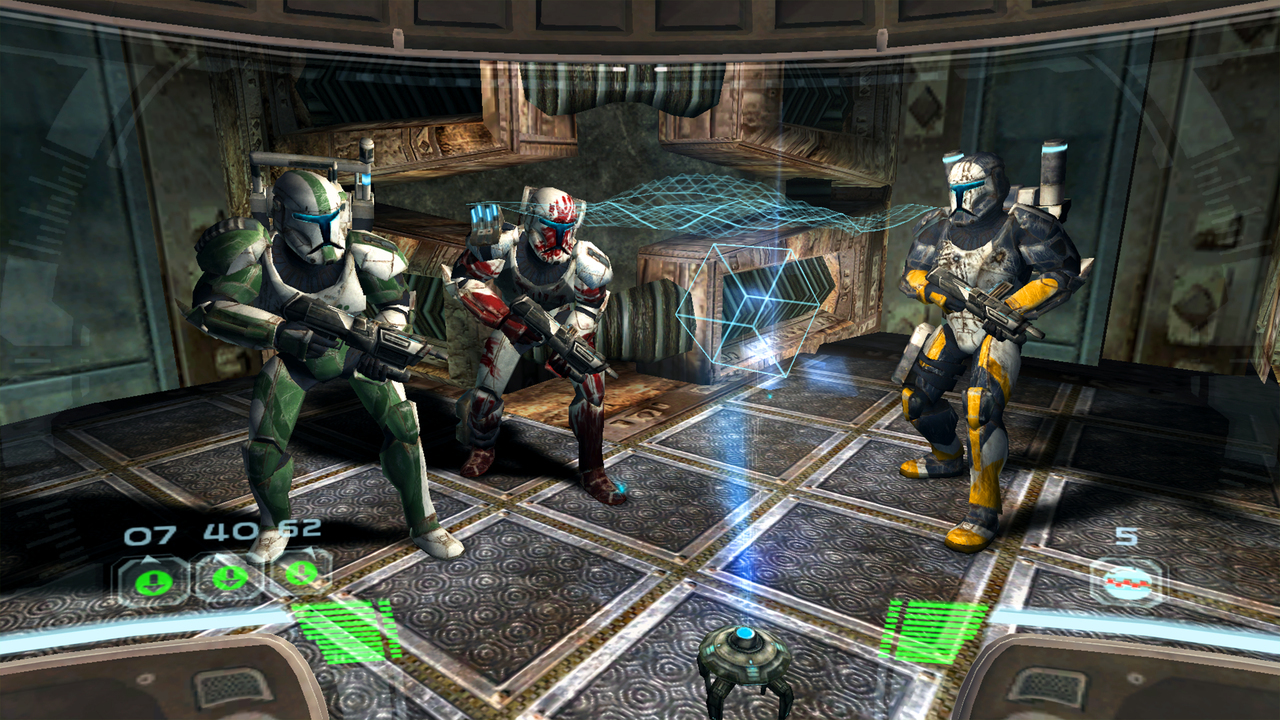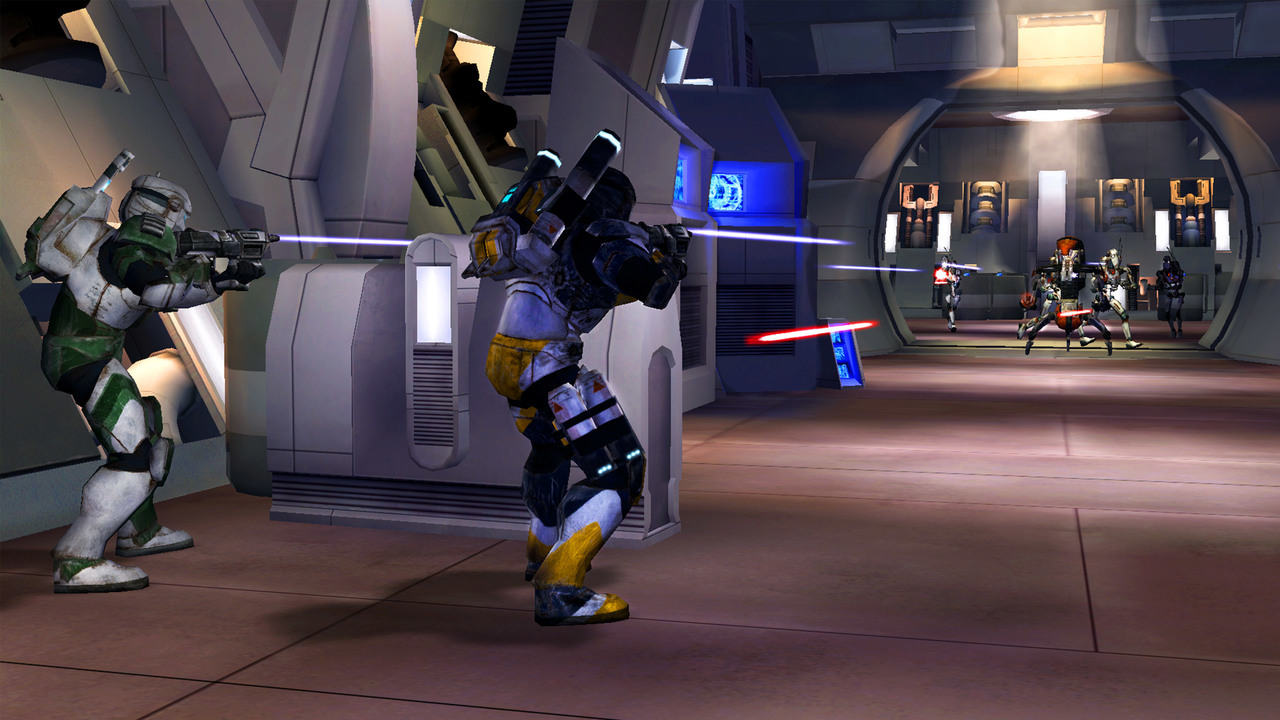First released in 2005, Star Wars: Republic Commando acted as many a young Star Wars fan's initial introduction to the concept that the clone troopers of the prequel trilogy are human beings--creating unique identities for the seemingly identical soldiers. Republic Commando has a strong legacy among Star Wars fans--despite the game's removal from the official canon, it remains a key part of the Star Wars universe, especially when it comes to video game entries.
Handled by Aspyr Media, Star Wars: Republic Commando Remastered brings the original 2005 Xbox and PC game to PS4 and Switch with enhanced HD graphics and modernized controls, though the multiplayer is absent. Otherwise, it's the same game. And though the flaws in its gameplay are only more noticeable now 16 years later, this remaster manages to still deliver a compelling story of four specialized commandos engaging in a variety of combat missions across the Clone Wars.
Squad Up
In Republic Commando, you play as RC-1138 aka "Boss," commanding sergeant of a specialized commando unit trained to take on missions that require a greater level of skill and cognitive ability than standard clone troopers possess. Your unit, Delta Squad, is also composed of sarcastic demolitions expert RC-1262 aka "Scorch," by-the-books hacker and technical analyst RC-1140 aka "Fixer," and morbidly grim sniper RC-1207 aka "Sev." The game takes place over several locations, beginning with an assignment on Geonosis at the end of Attack of the Clones and concluding on Kashyyyk just prior to the events of Revenge of the Sith.
The different actors for Boss (Temuera Morrison), Scorch (Raphael Sbarge), Fixer (Andrew Chaikin), and Sev (Jonathan David Cook) do most of the legwork in differentiating each member of the squad from one another. Most of the game sees all four working together, providing numerous opportunities for conversations between the squad. This helps to build a rapport with your AI-teammates--Scorch and Sev's brotherly rivalry with one another is still amusing years later, as are Fixer's repeated but useless reprimands for the two of them to act more like adults. As you're in command, the others look up to you as a big brother figure, and this familial bond creates a tendency to act protectively towards your squadmates.
That's a good thing, because that desire to keep your squad alive will help motivate you to make good decisions. Having elements of a tactical shooter, Republic Commando offers you options in how to lead your squad through combat gauntlets--these range from general orders such as "defend a spot" or "search and destroy," to more specific commands like telling Sev to use his sniper rifle from behind a certain piece of cover or tasking Scorch with setting a demolition charge on an obstacle in front of you. Holographic outlines of where a squadmate can do something will appear on your HUD, allowing you to know what options you have in each area and easily assign squadmates to where you want them to go.
The Illusion Of Command
Early on, there isn't much agency in how you can command your squad, which, along with the game's linear nature, can feel disappointingly restrictive. There's very little choice in how to tackle a problem on Geonosis--usually the solution is just given to you as you're funneled into a plan instead of making your own. But your possibilities do open up in later levels.
For example, my favorite part of the game has you enter a hangar where you know droid soldier dispensers are going to land--in fact you can see them in the distance, giving you a window of opportunity to quickly devise a plan before the fight breaks out. Throughout the hangar, there are spots where your squad can take up positions to snipe or throw grenades or man a turret, but there are also a dozen or so canisters where you or a squadmate can attach motion-sensing explosive traps. So it's a mad dash to get a good idea of how the hangar is laid out, decide where to assign your squad to do the most damage, and figure out where to put traps to plug the holes in your defense. It encourages you to make good judgment calls fast because the threat is so imminent. And it's impossible to do everything before the first dispenser arrives, forcing you to react to any of your mistakes. It's a tense moment but so incredibly rewarding, because it's one of the strongest examples of seeing how your plans can save the day.
Republic Commando doesn't give you something like that prior, nor does it do anything too similar for the rest of the campaign (there are a couple of other standout moments like it, but they don't quite require the same level of strategic prowess), which unfortunately means that this tactical game isn't actually all that tactical. Sure, you're directing the squad and making the decisions, but when the decision is whether or not you want to use a certain sniping spot (without much downside either way), the decision-making process isn't as impactful.

And that's where Republic Commando Remastered struggles the most. In 2005, the illusion that you were regularly making impactful decisions was only broken after playing the game several times and noticing that you were largely making similar decisions to your first run through the game. In 2021, with 16 more years of game design iteration to compare to, it's a lot more obvious. It's not like you can assign your fellow commandos to snipe from anywhere for instance, you can only tell them to snipe from predetermined locations and there's typically no more than one or two spots per area. If you enter an area and there's a computer to hack in order to proceed and one place to provide cover with sniper fire, the level design is automatically funneling you into solving the immediate problem by splicing into the computer and placing a sniper for overwatch support. Sure you could just choose to not place the sniper where the game has designated the ideal spot, but that doesn't really impact the battle other than making it a bit longer because no one is taking out the far-off targets since everyone in the squad is waiting for enemies to close in. That's not you making a strategy to the best of your tactical abilities, that's the level design telling you what to do--and there's no satisfaction in following someone else's plan in a game all about tactics.
And so for several moments throughout the game (especially the start), it can feel like you're just going through the motions of assigning squadmates to the two or three necessary positions that need filling. It's a problem that becomes less prominent further into the game when you start being put into larger spaces with four or more possible commands and thus giving you the opportunity to actually decide what you want to do, but your lack of agency as a commander never really goes away.
Even though tactical command options are fairly limited, the absence of them is still noticeable, and the rare moments when your tactical abilities are stripped from you are still incredibly effective at instilling a sense of vulnerability. After you build rapport with the other members of Delta Squad, you're occasionally thrown into situations where you must fight solo. With no teammates chirping in your ear, it's incredibly lonely and that feeling is reinforced through the gameplay in the lack of squadmates to assist you in battle--you can't assign Sev to cover you or task Fixer to slowly hack a computer while you and Scorch hold off an oncoming threat, you have to do everything on your own. It's definitely not as stressful as playing a survival horror game, but the sensation is similar; it sells the urgency of the situation where you need to reconvene with your squad as soon as you can. Even if your ability to direct your team is somewhat limited most of the time, your role as the commander builds a strong sense of camaraderie and it's noticeable when it's gone.
Changes In The Remaster
The lack of multiplayer is the remaster's most noticeable change, though admittedly, multiplayer was never Republic Commando's strong suit. The multiplayer included two variations of deathmatch and two variations of capture the flag on eight different maps that were inspired by levels from the campaign--it was your standard mid-2000s multiplayer shooter affair (meaning it was not Halo 2), and it lacked the squad-based banter that makes the single-player campaign as enjoyable as it is.
I also don't miss the game's old control scheme, which was somewhat annoying on the original Xbox. On Switch and PS4, the game takes advantage of the Joy-Con and DualShock 4's bumpers, two extra buttons that the original Xbox controller didn't have, in order to make switching grenades and visor modes easier.

For this review, I played Republic Commando Remastered on Switch. Playing it docked and with a gamepad controller is my preference considering it's easier to see far off targets on a larger screen, but the game holds up in handheld mode with the Joy-Con controllers too. Having not tested the remaster on PS4 (or PS5 via backwards compatibility), I can't comment on that version, but the Switch did hitch on occasion--basically every time the game loaded into a new area, registered a manual save, or tried to manage numerous enemies and/or explosions on the screen. It never put me in a more difficult situation, but it is noticeable and thus a bit annoying. My game also outright crashed once, but the generous auto save feature meant I only lost a few seconds of progress.
On Switch, aiming can take some getting used to, but Republic Commando is quite loose on demands for precision so the Joy-Con controllers can effectively line up a shot--you don't have to be exact, you just have to ensure your gun is aiming in the right direction. It's thankfully generous in what counts as a hit, so it's never frustrating that you can't achieve the same level of precision as a mouse and keyboard.
Same Game, New Paint Job
In the end, Republic Commando Remastered doesn't do anything to drastically change the experience of playing the original game. And to that end, its shortcomings have only become more apparent with time--tactical shooters have evolved to offer more satisfying experiences with choice and consequence--so you likely won't find much replayability here.
But it's still entertaining all things considered. If you loved its campaign back then, you'll see that it has aged well in some respects. And if you haven't played Republic Commando before, the remaster's upgraded graphics and modernized control scheme allow you to enjoy a game that's 16 years old.
Plus, Vode An, Republic Commando's main theme, is still the most epic piece of original composition made for a Star Wars video game, and that alone deserves to be experienced.